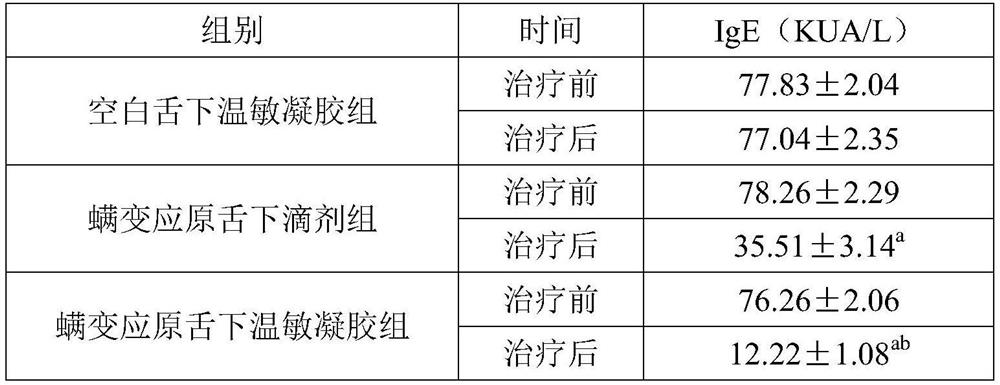Sublingual temperature-sensitive gel containing mite allergen and preparation method of sublingual temperature-sensitive gel
A temperature-sensitive gel and allergen technology, which is applied in the direction of allergen antigen components, medical preparations of non-active ingredients, pharmaceutical formulas, etc., can solve the problem of poor treatment effect of mite allergens, short sublingual mucosal residence time, immune Low response level and other problems, to achieve the effect of facilitating accurate dosing, shortening gelation time, and prolonging residence time
- Summary
- Abstract
- Description
- Claims
- Application Information
AI Technical Summary
Problems solved by technology
Method used
Image
Examples
Embodiment 1
[0026] Example 1 Preparation of sublingual thermosensitive gel for mite allergens
[0027] Prepare the temperature-sensitive gel material and cationic monomer into a 1mol / L mixed aqueous solution, adjust the pH to 7.2, add an initiator, and pass N 2 A copolymer was obtained after 2 h of polymerization. The product is purified by dialysis in water, and a cross-linking agent is added to obtain a copolymer hydrogel. The resulting hydrogel was soaked in distilled water for 1 week to remove unreacted monomer, crosslinker and initiator molecules in the gel. Then, under magnetic stirring at 4°C, slowly add the mite allergen and mix evenly to obtain the finished product.
Embodiment 2
[0028] Example 2 Screening of thermosensitive gel materials
[0029] Assuming that the content ratio of the temperature-sensitive gel material to the cationic monomer is a certain value (such as 1:1), the temperature-sensitive gel material is one of poloxamer and poly(N-isopropylacrylamide) (PNIPAM), and the cationic monomer The body is one of chitosan, carboxymethyl chitosan, (2-diethylamino) ethyl methacrylate, and trimethyl-3-acrylamidopropylamine chloride; by measuring the phase transition temperature , mucosal retention to explore the effects of different types of thermosensitive gel materials and cationic monomers.
[0030] In this example, the preparation method of the sublingual thermosensitive gel for mite allergens is shown in Implementation 1, and the measurement results are shown in Table 1.
[0031] 1. Phase transition temperature measurement method:
[0032]Take 10g of the prepared temperature-sensitive gel solution and pour it into a vial, put a magnetic stirr...
Embodiment 3
[0044] Example 3 Screening of the Content Ratio of Thermosensitive Gel Material and Cationic Monomer
[0045] This example intends to explore the influence of the content ratio of different temperature-sensitive gel materials and cationic monomers on the aforementioned indicators by measuring the phase transition temperature, logG*, adsorption rate, and gelation time.
[0046] In this example, see Example 1 for the preparation method of the sublingual temperature-sensitive gel for mite allergens; see Example 2 for the determination methods of phase transition temperature, mucosal retention, and adsorption rate; and see Table 2 for the measurement results.
[0047] 1. Determination method of gelation time:
[0048] Take 10g of the prepared temperature-sensitive gel solution and pour it into a vial, put a magnetic stirrer in the vial, put it in a constant-temperature water bath at 25°C for 20 minutes, then place it in a constant-temperature water bath at 37°C, start timing immed...
PUM
 Login to View More
Login to View More Abstract
Description
Claims
Application Information
 Login to View More
Login to View More - R&D
- Intellectual Property
- Life Sciences
- Materials
- Tech Scout
- Unparalleled Data Quality
- Higher Quality Content
- 60% Fewer Hallucinations
Browse by: Latest US Patents, China's latest patents, Technical Efficacy Thesaurus, Application Domain, Technology Topic, Popular Technical Reports.
© 2025 PatSnap. All rights reserved.Legal|Privacy policy|Modern Slavery Act Transparency Statement|Sitemap|About US| Contact US: help@patsnap.com



